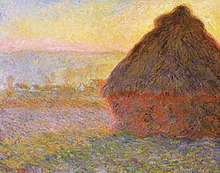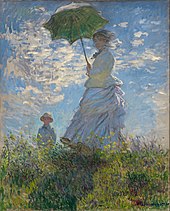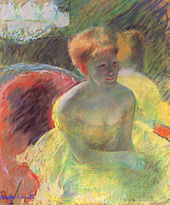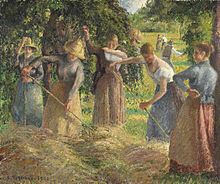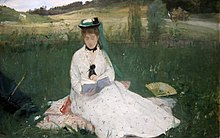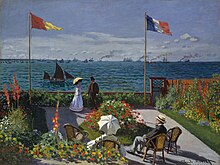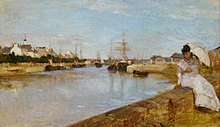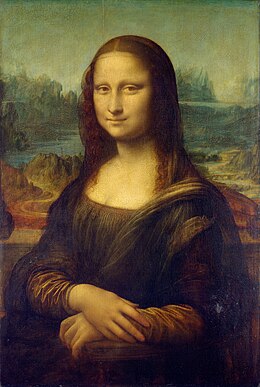Claude Monet, Impression, soleil levant (Impression, Sunrise), 1872, oil on canvas, Musée Marmottan Monet, Paris. This painting became the source of the movement's name, after Louis Leroy's article The Exhibition of the Impressionists satirically implied that the painting was at most, a sketch.
Impressionism is a 19th-century art movement characterized by relatively small, thin, yet visible brush strokes, open composition,
emphasis on accurate depiction of light in its changing qualities
(often accentuating the effects of the passage of time), ordinary
subject matter, inclusion of movement as a crucial element of
human perception and experience, and unusual visual angles.
Impressionism originated with a group of Paris-based artists whose
independent exhibitions brought them to prominence during the 1870s and
1880s.
The Impressionists faced harsh opposition from the conventional
art community in France. The name of the style derives from the title of
a Claude Monet work, Impression, soleil levant (Impression, Sunrise), which provoked the critic Louis Leroy to coin the term in a satirical review published in the Parisian newspaper Le Charivari.
The development of Impressionism in the visual arts was soon followed by analogous styles in other media that became known as impressionist music and impressionist literature.
Overview
J. M. W. Turner's atmospheric work was influential on the birth of Impressionism, here The Fighting Temeraire (1839)
Radicals in their time, early Impressionists violated the rules of
academic painting. They constructed their pictures from freely brushed
colours that took precedence over lines and contours, following the
example of painters such as Eugène Delacroix and J. M. W. Turner. They also painted realistic scenes of modern life, and often painted outdoors. Previously, still lifes and portraits as well as landscapes were usually painted in a studio. The Impressionists found that they could capture the momentary and transient effects of sunlight by painting outdoors or en plein air.
They portrayed overall visual effects instead of details, and used
short "broken" brush strokes of mixed and pure unmixed colour—not
blended smoothly or shaded, as was customary—to achieve an effect of
intense colour vibration.
Pierre-Auguste Renoir, Dance at Le Moulin de la Galette (Bal du moulin de la Galette), 1876, Musée d'Orsay, one of Impressionism's most celebrated masterpieces.
Impressionism emerged in France at the same time that a number of other painters, including the Italian artists known as the Macchiaioli, and Winslow Homer in the United States, were also exploring plein-air
painting. The Impressionists, however, developed new techniques
specific to the style. Encompassing what its adherents argued was a
different way of seeing, it is an art of immediacy and movement, of
candid poses and compositions, of the play of light expressed in a
bright and varied use of colour.
The public, at first hostile, gradually came to believe that the
Impressionists had captured a fresh and original vision, even if the art
critics and art establishment disapproved of the new style. By
recreating the sensation in the eye that views the subject, rather than
delineating the details of the subject, and by creating a welter of
techniques and forms, Impressionism is a precursor of various painting
styles, including Neo-Impressionism, Post-Impressionism, Fauvism, and Cubism.
Beginnings
In the middle of the 19th century—a time of change, as Emperor Napoleon III rebuilt Paris and waged war—the Académie des Beaux-Arts
dominated French art. The Académie was the preserver of traditional
French painting standards of content and style. Historical subjects,
religious themes, and portraits were valued; landscape and still life
were not. The Académie preferred carefully finished images that looked
realistic when examined closely. Paintings in this style were made up of
precise brush strokes carefully blended to hide the artist's hand in
the work. Colour was restrained and often toned down further by the application of a golden varnish.
The Académie had an annual, juried art show, the Salon de Paris,
and artists whose work was displayed in the show won prizes, garnered
commissions, and enhanced their prestige. The standards of the juries
represented the values of the Académie, represented by the works of such
artists as Jean-Léon Gérôme and Alexandre Cabanel.
In the early 1860s, four young painters—Claude Monet, Pierre-Auguste Renoir, Alfred Sisley, and Frédéric Bazille—met while studying under the academic artist Charles Gleyre.
They discovered that they shared an interest in painting landscape and
contemporary life rather than historical or mythological scenes.
Following a practice that had become increasingly popular by
mid-century, they often ventured into the countryside together to paint
in the open air,
but not for the purpose of making sketches to be developed into
carefully finished works in the studio, as was the usual custom.
By painting in sunlight directly from nature, and making bold use of
the vivid synthetic pigments that had become available since the
beginning of the century, they began to develop a lighter and brighter
manner of painting that extended further the Realism of Gustave Courbet and the Barbizon school. A favourite meeting place for the artists was the Café Guerbois on Avenue de Clichy in Paris, where the discussions were often led by Édouard Manet, whom the younger artists greatly admired. They were soon joined by Camille Pissarro, Paul Cézanne, and Armand Guillaumin.
Édouard Manet, The Luncheon on the Grass (Le déjeuner sur l'herbe), 1863
During the 1860s, the Salon jury routinely rejected about half of the
works submitted by Monet and his friends in favour of works by artists
faithful to the approved style. In 1863, the Salon jury rejected Manet's The Luncheon on the Grass (Le déjeuner sur l'herbe)
primarily because it depicted a nude woman with two clothed men at a
picnic. While the Salon jury routinely accepted nudes in historical and
allegorical paintings, they condemned Manet for placing a realistic nude
in a contemporary setting.
The jury's severely worded rejection of Manet's painting appalled his
admirers, and the unusually large number of rejected works that year
perturbed many French artists.
After Emperor Napoleon III saw the rejected works of 1863, he
decreed that the public be allowed to judge the work themselves, and the
Salon des Refusés
(Salon of the Refused) was organized. While many viewers came only to
laugh, the Salon des Refusés drew attention to the existence of a new
tendency in art and attracted more visitors than the regular Salon.
Alfred Sisley, View of the Saint-Martin Canal, Paris, 1870, Musée d'Orsay
Artists' petitions requesting a new Salon des Refusés in 1867, and again in 1872, were denied. In December 1873, Monet, Renoir, Pissarro, Sisley, Cézanne, Berthe Morisot, Edgar Degas and several other artists founded the Société Anonyme Coopérative des Artistes Peintres, Sculpteurs, Graveurs ("Cooperative and Anonymous Association of Painters, Sculptors, and Engravers") to exhibit their artworks independently. Members of the association were expected to forswear participation in the Salon. The organizers invited a number of other progressive artists to join them in their inaugural exhibition, including the older Eugène Boudin, whose example had first persuaded Monet to adopt plein air painting years before. Another painter who greatly influenced Monet and his friends, Johan Jongkind, declined to participate, as did Édouard Manet. In total, thirty artists participated in their first exhibition, held in April 1874 at the studio of the photographer Nadar.
Claude Monet, Haystacks, (sunset), 1890–1891, Museum of Fine Arts, Boston
The critical response was mixed. Monet and Cézanne received the harshest attacks. Critic and humorist Louis Leroy wrote a scathing review in the newspaper Le Charivari in which, making wordplay with the title of Claude Monet's Impression, Sunrise (Impression, soleil levant), he gave the artists the name by which they became known. Derisively titling his article The Exhibition of the Impressionists, Leroy declared that Monet's painting was at most, a sketch, and could hardly be termed a finished work.
He wrote, in the form of a dialog between viewers,
- Impression—I was certain of it. I was just telling myself that, since I was impressed, there had to be some impression in it ... and what freedom, what ease of workmanship! Wallpaper in its embryonic state is more finished than that seascape.
Claude Monet, Woman with a Parasol - Madame Monet and Her Son (Camille and Jean Monet), 1875, National Gallery of Art, Washington, D.C.
The term Impressionist quickly gained favour with the public.
It was also accepted by the artists themselves, even though they were a
diverse group in style and temperament, unified primarily by their
spirit of independence and rebellion. They exhibited together—albeit
with shifting membership—eight times between 1874 and 1886. The
Impressionists' style, with its loose, spontaneous brushstrokes, would
soon become synonymous with modern life.
Monet, Sisley, Morisot, and Pissarro may be considered the
"purest" Impressionists, in their consistent pursuit of an art of
spontaneity, sunlight, and colour. Degas rejected much of this, as he
believed in the primacy of drawing over colour and belittled the
practice of painting outdoors.
Renoir turned away from Impressionism for a time during the 1880s, and
never entirely regained his commitment to its ideas. Édouard Manet,
although regarded by the Impressionists as their leader,
never abandoned his liberal use of black as a colour (while
Impressionists avoided its use and preferred to obtain darker colours by
mixing), and never participated in the Impressionist exhibitions. He
continued to submit his works to the Salon, where his painting Spanish Singer
had won a 2nd class medal in 1861, and he urged the others to do
likewise, arguing that "the Salon is the real field of battle" where a
reputation could be made.
Camille Pissarro, Boulevard Montmartre, 1897, the Hermitage, Saint Petersburg
Among the artists of the core group (minus Bazille, who had died in the Franco-Prussian War
in 1870), defections occurred as Cézanne, followed later by Renoir,
Sisley, and Monet, abstained from the group exhibitions so they could
submit their works to the Salon. Disagreements arose from issues such as
Guillaumin's membership in the group, championed by Pissarro and
Cézanne against opposition from Monet and Degas, who thought him
unworthy. Degas invited Mary Cassatt to display her work in the 1879 exhibition, but also insisted on the inclusion of Jean-François Raffaëlli, Ludovic Lepic,
and other realists who did not represent Impressionist practices,
causing Monet in 1880 to accuse the Impressionists of "opening doors to
first-come daubers". The group divided over invitations to Paul Signac and Georges Seurat to exhibit with them in 1886. Pissarro was the only artist to show at all eight Impressionist exhibitions.
The individual artists achieved few financial rewards from the
Impressionist exhibitions, but their art gradually won a degree of
public acceptance and support. Their dealer, Durand-Ruel,
played a major role in this as he kept their work before the public and
arranged shows for them in London and New York. Although Sisley died in
poverty in 1899, Renoir had a great Salon success in 1879.
Monet became secure financially during the early 1880s and so did
Pissarro by the early 1890s. By this time the methods of Impressionist
painting, in a diluted form, had become commonplace in Salon art.
Impressionist techniques
Mary Cassatt, Lydia Leaning on Her Arms (in a theatre box), 1879
French painters who prepared the way for Impressionism include the Romantic colourist Eugène Delacroix, the leader of the realists Gustave Courbet, and painters of the Barbizon school such as Théodore Rousseau. The Impressionists learned much from the work of Johan Barthold Jongkind, Jean-Baptiste-Camille Corot and Eugène Boudin,
who painted from nature in a direct and spontaneous style that
prefigured Impressionism, and who befriended and advised the younger
artists.
A number of identifiable techniques and working habits
contributed to the innovative style of the Impressionists. Although
these methods had been used by previous artists—and are often
conspicuous in the work of artists such as Frans Hals, Diego Velázquez, Peter Paul Rubens, John Constable, and J. M. W. Turner—the Impressionists were the first to use them all together, and with such consistency. These techniques include:
- Short, thick strokes of paint quickly capture the essence of the subject, rather than its details. The paint is often applied impasto.
- Colours are applied side-by-side with as little mixing as possible, a technique that exploits the principle of simultaneous contrast to make the colour appear more vivid to the viewer.
- Grays and dark tones are produced by mixing complementary colours. Pure impressionism avoids the use of black paint.
- Wet paint is placed into wet paint without waiting for successive applications to dry, producing softer edges and intermingling of colour.
- Impressionist paintings do not exploit the transparency of thin paint films (glazes), which earlier artists manipulated carefully to produce effects. The impressionist painting surface is typically opaque.
- The paint is applied to a white or light-coloured ground. Previously, painters often used dark grey or strongly coloured grounds.
- The play of natural light is emphasized. Close attention is paid to the reflection of colours from object to object. Painters often worked in the evening to produce effets de soir—the shadowy effects of evening or twilight.
- In paintings made en plein air (outdoors), shadows are boldly painted with the blue of the sky as it is reflected onto surfaces, giving a sense of freshness previously not represented in painting. (Blue shadows on snow inspired the technique.)
New technology played a role in the development of the style.
Impressionists took advantage of the mid-century introduction of
premixed paints in tin tubes (resembling modern toothpaste tubes), which
allowed artists to work more spontaneously, both outdoors and indoors.
Previously, painters made their own paints individually, by grinding
and mixing dry pigment powders with linseed oil, which were then stored
in animal bladders.
Many vivid synthetic pigments became commercially available to
artists for the first time during the 19th century. These included cobalt blue, viridian, cadmium yellow, and synthetic ultramarine blue, all of which were in use by the 1840s, before Impressionism. The Impressionists' manner of painting made bold use of these pigments, and of even newer colours such as cerulean blue, which became commercially available to artists in the 1860s.
The Impressionists' progress toward a brighter style of painting
was gradual. During the 1860s, Monet and Renoir sometimes painted on
canvases prepared with the traditional red-brown or grey ground.
By the 1870s, Monet, Renoir, and Pissarro usually chose to paint on
grounds of a lighter grey or beige colour, which functioned as a middle
tone in the finished painting.
By the 1880s, some of the Impressionists had come to prefer white or
slightly off-white grounds, and no longer allowed the ground colour a
significant role in the finished painting.
Content and composition
Camille Pissarro, Hay Harvest at Éragny, 1901, National Gallery of Canada, Ottawa, Ontario
Prior to the Impressionists, other painters, notably such 17th-century Dutch painters as Jan Steen, had emphasized common subjects, but their methods of composition were traditional. They arranged their compositions so that the main subject commanded the viewer's attention. J. M. W. Turner, while an artist of the Romantic era, anticipated the style of impressionism with his artwork.
The Impressionists relaxed the boundary between subject and background
so that the effect of an Impressionist painting often resembles a
snapshot, a part of a larger reality captured as if by chance. Photography
was gaining popularity, and as cameras became more portable,
photographs became more candid. Photography inspired Impressionists to
represent momentary action, not only in the fleeting lights of a
landscape, but in the day-to-day lives of people.
Berthe Morisot, Reading, 1873, Cleveland Museum of Art
The development of Impressionism can be considered partly as a
reaction by artists to the challenge presented by photography, which
seemed to devalue the artist's skill in reproducing reality. Both
portrait and landscape
paintings were deemed somewhat deficient and lacking in truth as
photography "produced lifelike images much more efficiently and
reliably".
In spite of this, photography actually inspired artists to pursue
other means of creative expression, and rather than compete with
photography to emulate reality, artists focused "on the one thing they
could inevitably do better than the photograph—by further developing
into an art form its very subjectivity in the conception of the image,
the very subjectivity that photography eliminated".
The Impressionists sought to express their perceptions of nature,
rather than create exact representations. This allowed artists to depict
subjectively what they saw with their "tacit imperatives of taste and
conscience".
Photography encouraged painters to exploit aspects of the painting
medium, like colour, which photography then lacked: "The Impressionists
were the first to consciously offer a subjective alternative to the
photograph".
Claude Monet, Jardin à Sainte-Adresse, 1867, Metropolitan Museum of Art, New York., a work showing the influence of Japanese prints
Another major influence was Japanese ukiyo-e art prints (Japonism).
The art of these prints contributed significantly to the "snapshot"
angles and unconventional compositions that became characteristic of
Impressionism. An example is Monet's Jardin à Sainte-Adresse, 1867, with its bold blocks of colour and composition on a strong diagonal slant showing the influence of Japanese prints
Edgar Degas was both an avid photographer and a collector of Japanese prints. His The Dance Class (La classe de danse)
of 1874 shows both influences in its asymmetrical composition. The
dancers are seemingly caught off guard in various awkward poses, leaving
an expanse of empty floor space in the lower right quadrant. He also
captured his dancers in sculpture, such as the Little Dancer of Fourteen Years.
Women Impressionists
Impressionists, in varying degrees, were looking for ways to depict visual experience and contemporary subjects.
Women Impressionists were interested in these same ideals but had many
social and career limitations compared to male Impressionists. In
particular, they were excluded from the imagery of the bourgeois social
sphere of the boulevard, cafe, and dance hall.
As well as imagery, women were excluded from the formative discussions
that resulted in meetings in those places; that was where male
Impressionists were able to form and share ideas about Impressionism.
In the academic realm, women were believed to be incapable of handling
complex subjects which led teachers to restrict what they taught female
students.
It was also considered unladylike to excel in art since women's true
talents were then believed to center on homemaking and mothering.
Yet several women were able to find success during their
lifetime, even though their careers were affected by personal
circumstances – Bracquemond, for example, had a husband who was
resentful of her work which caused her to give up painting. The four most well known, namely, Mary Cassatt, Eva Gonzalès, Marie Bracquemond,
and Berthe Morisot, are, and were, often referred to as the 'Women
Impressionists'. Their participation in the series of eight
Impressionist exhibitions that took place in Paris from 1874 to 1886
varied: Morisot participated in seven, Cassatt in four, Bracquemond in
three, and Gonzalès did not participate.
The critics of the time lumped these four together without regard to their personal styles, techniques, or subject matter.
Critics viewing their works at the exhibitions often attempted to
acknowledge the women artists' talents but circumscribed them within a
limited notion of femininity. Arguing for the suitability of Impressionist technique to women's manner of perception, Parisian critic S.C. de Soissons wrote:
One can understand that women have no originality of thought, and that literature and music have no feminine character; but surely women know how to observe, and what they see is quite different from that which men see, and the art which they put in their gestures, in their toilet, in the decoration of their environment is sufficient to give is the idea of an instinctive, of a peculiar genius which resides in each one of them.
While
Impressionism legitimized the domestic social life as subject matter,
of which women had intimate knowledge, it also tended to limit them to
that subject matter. Portrayals of often-identifiable sitters in
domestic settings (which could offer commissions) were dominant in the
exhibitions.
The subjects of the paintings were often women interacting with their
environment by either their gaze or movement. Cassatt, in particular,
was aware of her placement of subjects: she kept her predominantly
female figures from objectification and cliche; when they are not
reading, they converse, sew, drink tea, and when they are inactive, they
seem lost in thought.
Mary Cassatt, Young Girl at a Window, 1885, oil on canvas, National Gallery of Art, Washington, D.C.
Eva Gonzalès, Une Loge aux Italiens, or, Box at the Italian Opera, ca. 1874, oil on canvas, Musée d'Orsay, Paris
The women Impressionists, like their male counterparts, were striving
for "truth," for new ways of seeing and new painting techniques; each
artist had an individual painting style.
Women Impressionists (particularly Morisot and Cassatt) were conscious
of the balance of power between women and objects in their paintings –
the bourgeois women depicted are not defined by decorative objects, but
instead, interact with and dominate the things with which they live. There are many similarities in their depictions of women who seem both at ease and subtly confined. Gonzalès' Box at the Italian Opera
depicts a woman staring into the distance, at ease in a social sphere
but confined by the box and the man standing next to her. Cassatt's
painting Young Girl at a Window is brighter in color but remains constrained by the canvas edge as she looks out the window.
Despite their success in their ability to have a career and
Impressionism's demise attributed to its allegedly feminine
characteristics (its sensuality, dependence on sensation, physicality,
and fluidity) the four women artists (and other, lesser-known women
Impressionists) were largely omitted from art historical textbooks
covering Impressionist artists until Tamar Garb's Women Impressionists published in 1986. For example, Impressionism by Jean Leymarie, published in 1955 included no information on any women Impressionists.
Main Impressionists
Berthe Morisot, The Harbour at Lorient, 1869, National Gallery of Art, Washington, D.C.
Claude Monet, Tulip Fields in Holland (Champs de Tulipes en Holland), 1886, Musée d'Orsay
The central figures in the development of Impressionism in France, listed alphabetically, were:
- Frédéric Bazille (who only posthumously participated in the Impressionist exhibitions) (1841–1870)
- Gustave Caillebotte (who, younger than the others, joined forces with them in the mid-1870s) (1848–1894)
- Mary Cassatt (American-born, she lived in Paris and participated in four Impressionist exhibitions) (1844–1926)
- Paul Cézanne (although he later broke away from the Impressionists) (1839–1906)
- Edgar Degas (who despised the term Impressionist) (1834–1917)
- Armand Guillaumin (1841–1927)
- Édouard Manet (who did not participate in any of the Impressionist exhibitions) (1832–1883)
- Claude Monet (the most prolific of the Impressionists and the one who embodies their aesthetic most obviously) (1840–1926)
- Berthe Morisot (who participated in all Impressionist exhibitions except in 1879) (1841–1895)
- Camille Pissarro (1830–1903)
- Pierre-Auguste Renoir (who participated in Impressionist exhibitions in 1874, 1876, 1877 and 1882) (1841–1919)
- Alfred Sisley (1839–1899)





